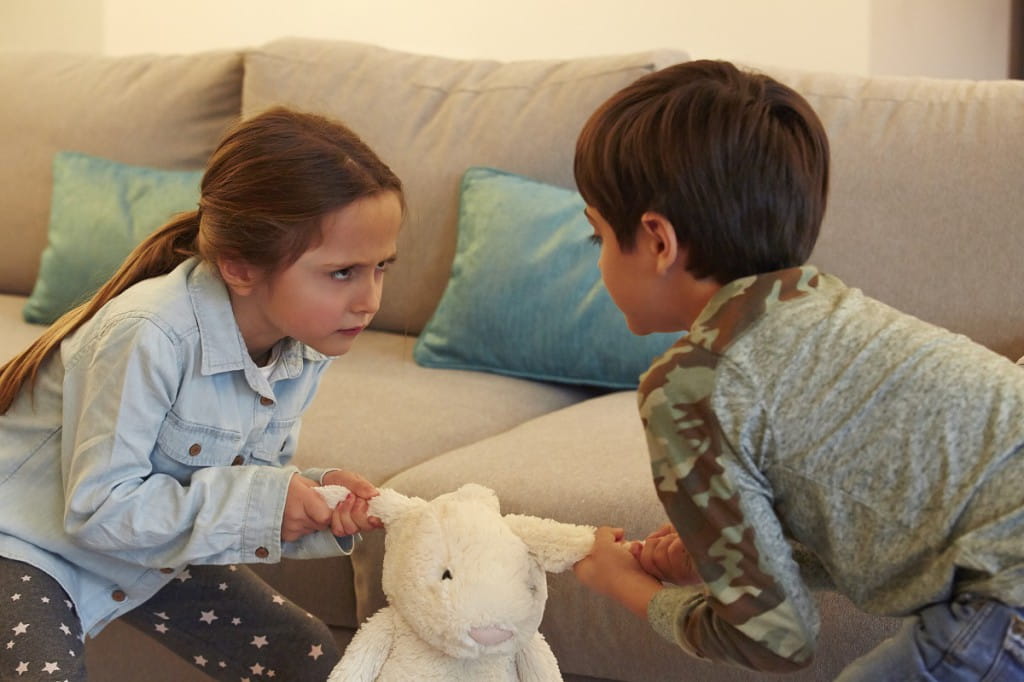Kids Fighting All the Time? 11 Ways to Stop the Squabbles and Build a Family Team

by Kim DeMarchi
No one likes it when their children bicker and battle. It’s draining and exhausting to listen to, and it can even decrease the emotional safety in the home—exactly the place where everybody has the right to feel 100 percent safe.
Why do they squabble so? Well, for many, many reasons (hunger, boredom, and exhaustion, to name a few concrete examples). But arguably the most important reasons for sibling quarrels is for attention—their parents’ attention to be more specific. A heated sibling battle, after all, is almost always guaranteed to bring a parent into the room—and when mom gets there, she’s likely to be laser-focused on the kids and the problem at hand.
Unfortunately, that kind of parental attention isn’t exactly the right kind of attention.
I want to emphasize that the No. 1 way to teach conflict resolution and kindness is to model those things yourself. Make no mistake: Your children are watching everything you do and hearing everything you say and how you say it.
Build Team Family
- Establish a We (versus a Me) mentality. “Whose team are you on!?” “Team Spires-DeMarchi!” Yes, in our family, we literally have a cheer and a special handshake. You don’t have to go that route, but do look for ways to build your own united front that supports and stands up for one another. Depending on their age, have your children create projects and goals they want to accomplish together: for example, they might hold a mini-garage sale with proceeds to buy a new Lego set they both want.
- Create a sibling treasure jar. Put jewels in the jar when you see either of them doing something nice for the other one or making a good choice not to tease back. Once the jar is filled, they can choose what they’d like to do together: go to an aquarium, the movies, or a family fun center, for example.
- Make a kindness tree. Start with a construction-paper trunk on a wall. Add leaves to the tree when you catch one of them doing something kind for the other, such as helping them clean up the toys.
- Celebrate their relationship. Let them make or buy gifts for each other for birthdays and holidays. Encourage times where they just go do an activity together (without friends). Declare “Sibling Sundays,” when they get to watch a movie and eat popcorn together. Keep them on the same team when playing board games against parents.
- Arrange time for them to be apart from one another. Each child needs quality time alone with each parent. Have an outing together, go on a dinner date, arrange for separate play dates, and let each child go visit Grandma without the other sibling.
- Treat and love each child fairly and uniquely, not equally. We all have different needs. Different children require different kinds of attention at different times.
- Have community property and individual property. Generally speaking, most items should be community property—balls, puzzles, books, and games for example. Individual property is for “special” items. Perhaps it was a birthday gift or something they saved up for. Those items should be put somewhere special, with the rule that permission needs to be granted before they are used by the other sibling.
Adopt the Language of Neutrality
- Avoid labeling. I love that picture! You are definitely the artist in our family! This sounds like a positive statement, but labels like artsy, athletic, or smart can inadvertently create competition. After all, if your not-so-creative child loves art, that passion is worth nurturing. The language of neutrality let’s her know you care about her: You really enjoy art, don’t you? I can certainly tell!
- Minimize comparisons. Whether comparisons are positive or negative, they have the same unintended effect on your children. Instead of: You can ride your two wheeler now, not like your sister who still rides her tricycle, try self-esteem-building statements like You look very proud of yourself that you’ve learned how to ride a two-wheeler.
Become a Master Mediator
- Treat each child the same. Instead of trying to figure out who was the instigator (we don’t really know what happened), you can say something like, “Kids, do you need to go to your feel-good places for a while or do you want to work on a solution now?”
- Don’t play favorites. The child you are having trouble appreciating in the heat of the moment is exactly the child who also needs your love and attention. Be sensitive to this.
It’s really not possible to eliminate all conflict. But it is possible to increase the bonds, trust, and warmth in your home. It’s also important to take time to teach our young children the conflict-resolution tools they can use with loved ones, friends, and coworkers in the future. What a child doesn’t receive or have, after all, he can seldom later give.





